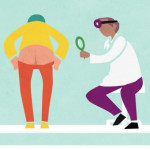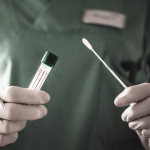New cases and deaths from anal cancer rose dramatically in the United States in recent years, according to a new study. With an increase of nearly 3% per year, anal cancer is one of the most rapidly rising causes of cancer incidence and mortality. But more widespread screening and human papillomavirus (HPV) vaccination could reverse this trend.
“It is concerning that over 75% of U.S. adults do not know that HPV causes this preventable cancer,” lead author Ashish Deshmukh, PhD, MPH, of the University of Texas Health Science Center in Houston, said in a press release. “Educational campaigns are needed to increase awareness about the rising rates of anal cancer and importance of immunization.”
High-risk HPV types—especially HPV-16 and HPV-18—can cause anal, cervical, oral and other types of cancer. HPV is one of the most common sexually transmitted infections, and most people acquire one or more types soon after they become sexually active. Risk factors include receptive anal intercourse, having multiple sex partners, being HIV positive or having compromised immune function for other reasons.
Anal cancer is uncommon, with about 8,300 new cases expected in 2019, according to the American Cancer Society. Gay and bisexual men have the highest rate of anal cancer, although the absolute number of cases is about twice as high among women compared with men.
As described in the Journal of the National Cancer Institute, Deshmukh’s team looked at national trends in anal cancer incidence (new cases) and mortality. This retrospective analysis, which included data from all cancer registries in the United States, identified 68,809 cases of anal cancer and 12,111 related deaths between 2001 and 2016.
Most patients with anal cancer (82%) were white, 10% were Black and 7% were Hispanic. About 30% were in the 50 to 59 age group, followed by those ages 70 or older (25%) and those ages 60 to 69 (25%). That is, about 80% were age 50 or older.
Overall anal cancer incidence rose by 2.7% during the study period. The largest increase was seen in those ages 50 to 59 (4.5%). Among men, the increase was higher for Black compared with white men (2.8% versus 2.3%), while among women, the increase was higher for white compared with Black women (3.7% versus 2.6%). Looking at birth cohorts, the researchers found that young Black men in their 30s had a fivefold higher rate than those in their 70s. Older women also had a disproportionately high rate.
Also of concern, a growing number of people were diagnosed with anal cancer at later stages of the disease, after it had spread elsewhere in the body (a process known as metastasis). Metastatic anal cancer rose by 8.6% among men and by 7.5% among women. In contrast, diagnosis of early-stage, or localized, disease rose by just 1.3% and 2.3%, respectively. If caught early, abnormal cells can often be removed or destroyed before they spread.
Anal cancer deaths increased by a similar amount, 3.1% per year overall. Annual mortality rates rose by 3.4% among men and by 2.9% among women. Here, the largest jump was seen in the 60 to 69 age group (4.9%). Mortality rates increased by 3.3% annually for whites and by 3.2% for Blacks.
Since the 1950s, the study authors noted, anal sex has become more common, and people have more sex partners on average, which could help explain the increase in anal cancer. Rising rates of obesity may also play a role. Older people may be more prone to anal cancer progression and death because of compromised immune function.
The HIV epidemic also could have contributed to the rise, the researchers suggested. Improvements in antiretroviral treatment starting in the mid-1990s have enabled HIV-positive people to live longer, giving them more time to develop this cancer. Young Black men, who had a high anal cancer rate in this study, are also disproportionately affected by HIV. “The distinct pattern in [anal cancer] incidence seems to have mirrored the differences in AIDS diagnosis trends by age and race among birth cohorts,” the authors wrote.
Screening and Vaccination
As Deshmukh notes, more than 75% of Americans are unaware of the link between HPV and anal cancer, and only about half of those in the eligible age range have been vaccinated.
Anal cancer is often neglected and stigmatized, despite the high-profile death of actress Farrah Fawcett of Charlie’s Angels fame and the recent revelation of an anal cancer diagnosis by former Desperate Housewives star Marcia Cross, according to the University of Texas press release.
Fortunately, anal carcinoma is one of the most preventable cancers. Routine screening with Pap smears has dramatically reduced deaths from cervical cancer in the United States, though mortality remains high among women in countries where this is not widely done. Current guidelines do not recommend the equivalent screening for anal cancer, but some clinicians who see many men who have sex with men and people with HIV are doing it.
“Screening for anal cancer is not currently performed, except in certain high-risk groups, and the results of this study suggest that evaluation of broader screening efforts should be considered,” said senior study author Keith Sigel, MD, PhD, MPH, of Icahn School of Medicine at Mount Sinai.
What to do with the results of such screening is not yet clear. People typically first develop precancerous cell changes known as dysplasia or squamous intraepithelial lesions. But disease progression can be quite variable. Low-grade changes do not always lead to high-grade lesions (known as HSIL), HSIL does not always progress to invasive cancer and dysplasia may improve on its own without treatment.
HSIL can be treated using a variety of approaches, but side effects are common. The ongoing ANCHOR study is randomly assigning HIV-positive men and women diagnosed with HSIL to either receive immediate treatment or undergo active monitoring, to determine whether such treatment reduces the risk of developing anal cancer.
The Gardasil 9 vaccine protects against nine types of HPV that cause cancer or genital and anal warts. The Centers for Disease Control and Prevention (CDC) recommends vaccination for girls and boys at age 11 or 12, with catch-up vaccines for those up to age 26 who did not receive them as adolescents. In 2018, the Food and Drug Administration approved Gardasil 9 for women and men up to age 45. The CDC advises that people between 27 and 45 should have a discussion with their health care providers about whether they might still benefit from vaccination.
The groups with the highest anal cancer rates in this study came of age well before the first HPV vaccine was approved in 2006. The original Gardasil was initially approved for young women, with young men added later and the upper age limit subsequently raised for both sexes. Studies have already shown that infection with cancer-causing HPV types and development of cervical precancer have declined in vaccinated age groups. Even those who are not vaccinated themselves can benefit, thanks to a phenomenon known as herd immunity. Future research will reveal whether widespread vaccination reduces rates of anal cancer and other HPV-related malignancies.
Click here to read the study abstract.
Click here to learn more about anal cancer.







1 Comment
1 Comment